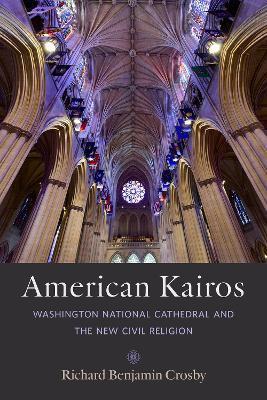American Kairos: Washington National Cathedral and the New Civil Religion

American Kairos: Washington National Cathedral and the New Civil Religion
A history of Washington National Cathedral and the theory of an American civil religion.
In 1792, Pierre Charles L'Enfant, the first city planner of Washington, DC, introduced the idea of a "great church for national purposes." Unlike L'Enfant's plans for the White House, the US Capitol, and the National Mall, this grand temple to the republic never materialized. But in 1890, the Episcopal Church began planning what is known today as Washington National Cathedral.
In American Kairos, Richard Benjamin Crosby chronicles the history of not only the building but also the idea that animates it, arguing that the cathedral is a touchstone site for the American civil religion--the idea that the United States functions much like a religion, with its own rituals, sacred texts, holy days, and so on. He shows that the National Cathedral can never be the church L'Enfant envisioned, but it can be a starting point for studying the conflicts over belonging, ideology, and America's place in the world that define the American civil religion. By examining correspondence between L'Enfant, George Washington, Thomas Jefferson, and others, and by diving into Washington National Cathedral's archives, Crosby uncovers a crucial gap in the formation of the nation's soul.
While L'Enfant's original vision was never realized, Washington National Cathedral reminds us that perhaps it can be. The cathedral is one of the great rhetorical and architectural triumphs in the history of American religion. Without government mandate or public vote, it has claimed its role as America's de facto house of worship, a civil religious temple wherein Americans conduct some of their highest, holiest rituals, including state funerals and National Day of Prayer services.
PRP: 441.26 Lei
Acesta este Pretul Recomandat de Producator. Pretul de vanzare al produsului este afisat mai jos.
397.13Lei
397.13Lei
441.26 LeiLivrare in 2-4 saptamani
Descrierea produsului
A history of Washington National Cathedral and the theory of an American civil religion.
In 1792, Pierre Charles L'Enfant, the first city planner of Washington, DC, introduced the idea of a "great church for national purposes." Unlike L'Enfant's plans for the White House, the US Capitol, and the National Mall, this grand temple to the republic never materialized. But in 1890, the Episcopal Church began planning what is known today as Washington National Cathedral.
In American Kairos, Richard Benjamin Crosby chronicles the history of not only the building but also the idea that animates it, arguing that the cathedral is a touchstone site for the American civil religion--the idea that the United States functions much like a religion, with its own rituals, sacred texts, holy days, and so on. He shows that the National Cathedral can never be the church L'Enfant envisioned, but it can be a starting point for studying the conflicts over belonging, ideology, and America's place in the world that define the American civil religion. By examining correspondence between L'Enfant, George Washington, Thomas Jefferson, and others, and by diving into Washington National Cathedral's archives, Crosby uncovers a crucial gap in the formation of the nation's soul.
While L'Enfant's original vision was never realized, Washington National Cathedral reminds us that perhaps it can be. The cathedral is one of the great rhetorical and architectural triumphs in the history of American religion. Without government mandate or public vote, it has claimed its role as America's de facto house of worship, a civil religious temple wherein Americans conduct some of their highest, holiest rituals, including state funerals and National Day of Prayer services.
Detaliile produsului








